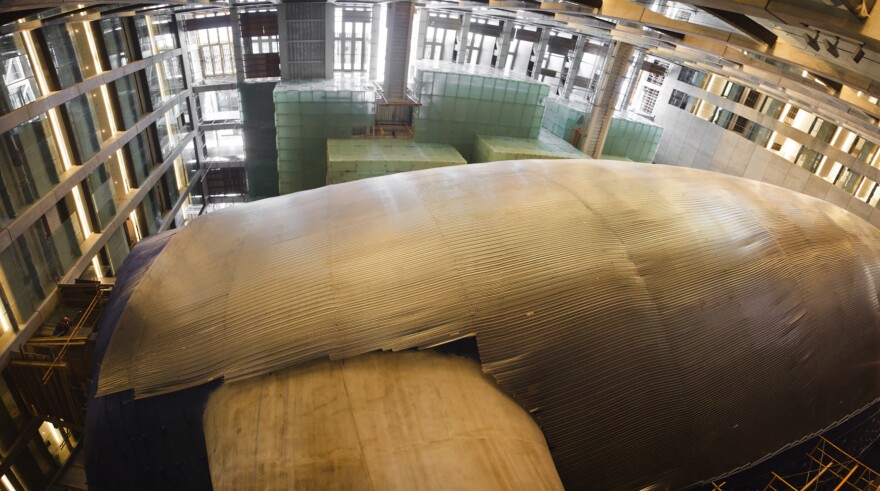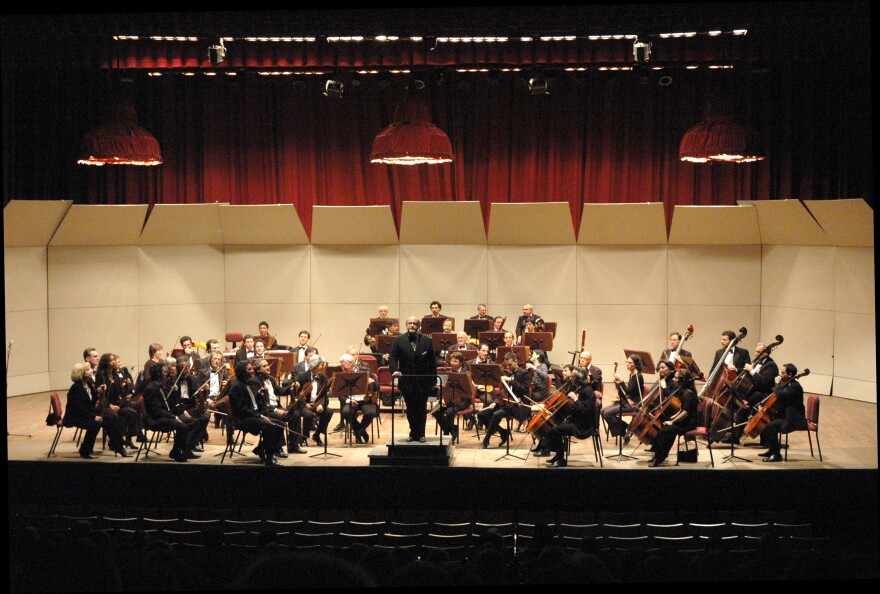A new tourist attraction in Argentina — The Centro Cultural Kirchner in downtown Buenos Aires — has been posting some impressive numbers since it opened in mid-May. As many as 10,000 patrons a day are trooping through an ornate, turn-of-the-last-century building that has been converted into what's said to be the fourth-largest cultural center in the world. Remarkably, everything in it is free, from video installations to comedy acts to symphony concerts.

They call the main concert hall La Ballena Azul, "The Blue Whale," and it swims inside a grand Beaux Arts palace where, for most of the last century, folks in Buenos Aires mailed letters: the former Central Post Office. The Blue Whale auditorium — blimp-shaped, three stories high, holding 1,750 people — floats in what used to be the package-sorting area.
Why "floats"? Because the subway runs nearby, says guide Federico Baggio. "So the vibrations would not enter the symphony hall. It ended up having a whale shape, so that's why they named it like that, but the purpose is acoustics."

The Blue Whale is the most eye-catching attraction in the new Kirchner Cultural Center, but even it can't upstage its surroundings. The Palacio de Correos, literally the "Postal Palace" — commissioned in 1889 and completed almost 30 years later — was the largest public building in Argentina when it opened in 1928. It's eight stories tall, occupies a full city block behind a French Second Empire facade, and contains almost 1 million square feet of marble hallways, stained-glass ceilings and windows. You can also find traces of original post office fixtures, such as mailboxes and grand marble counters where you could finish and address your letters.
When the new architects changed things, to add, say, elevators, or a boxy, chandelier-like structure above the Blue Whale that's big enough to mount exhibits in, they purposely used different materials: frosted glass, stainless steel. That way you never lose sight of the the ornate beauty of the original building — beauty that enticed President Juan Peron to move his presidential offices here in the 1940s from the nearby Casa Rosada.

And the grandest room — a spectacular vaulted space the size of a banquet hall that had been the office of the postal service director — became the headquarters for the Eva Peron Foundation, which dispensed charity and gifts to impoverished Argentine citizens. That space has been restored as a sort of museum exhibit, with everything from Eva Peron's desk to bottles of champagne, letters piled all the way to the 20-foot ceiling in one corner, dozens of toys, go-carts, and other gifts of the sort she dispensed.
Approaching the desk, you hear recordings of actors' voices re-creating what went on there — children excited over Christmas toys, or asking first lady "Evita" for something for their grandparents. It's a scene some older visitors can remember from real life, and occasionally prompts tears.
These historic details resonated with the late President Nestor Kirchner, for whom the cultural center is now named, and for his widow, Cristina Fernandez de Kirchner, who succeeded him as president. They're from the Peronist party, and like Juan and Eva Peron, who founded that party, as well as such cultural institutions as the Argentine National Symphony, the arts are baked into their worldview, says Culture Minister Teresa Parodi.
"Culture is an investment for this government, not an expense," she says.

So when Kirchner saw this abandoned building, the thought was "not to turn it into a shopping mall, or" — as happened to Washington, D.C.'s Old Post Office — "a grand hotel. Instead, they pictured a cultural space — an enormous workshop where people can be developers of their own culture."
Parodi is herself a well-known singer/songwriter in Latin America, and when she accepted the Cabinet-level position of minister of culture, launching the new Kirchner Center became her responsibility.
At its debut on May 21, it was a work in progress, and even months later, there is work going on. Performance halls are complete, and six floors of art galleries are getting there, many devoted to what you might call art that's "gone postal": stamps in collages, a town's response when every citizen received a letter with a different story, performance art video installations about mail that aggravates and inflames.
The public sector in Argentina, says Parodi, operates on the assumption that the arts belong to everyone.
"We consider culture to be a right," she says.

That's why the Culture Ministry stages concerts and workshops for the homeless in shantytowns, and why, at the Kirchner Center, everything is currently free. There will eventually be a "symbolic payment," she says, noting that the building needs to be kept up, and artists paid for their work. But she says corporations will be invited to sponsor events and keep prices low and seats and galleries full, as they are now.
During his tour, Baggio notes that whenever the audience fills the building, Thursday to Sunday, it regains the feeling of all those people rushing to deliver mail, moving everywhere with this rhythm of rush hour.
That rhythm is clearly benefiting the artists who play here. Especially the Argentine National Symphony. The Perons may have founded it in 1948, but they didn't provide it with a home, and it has wandered, homeless for 67 years, from opera house to concert hall to auditorium.
Now, to the evident delight of the public, it has taken up permanent residency at the Kirchner Center. In July, the symphony hosted Argentina's own Martha Argerich, one of the world's great classical pianists. Parodi says 1.2 million people tried to access the ticket website (they collapsed it) for an auditorium that holds fewer than 2,000. "She was bigger than the Rolling Stones," Parodi marvels, "which speaks well for a country that is very cultured."

In keeping with the building's origins, that symphony concert also included music from the movie The Postman, conducted by its Argentine composer Luis Enriquez Bacalov, as well as tango selections. And in keeping with the idea that culture should belong to everyone — and that 1.2 million people had wanted to hear Argerich — it was simulcast nationally on radio and TV.
Parodi seems so personally devoted to the ideas espoused by the Culture Ministry that I asked her whether she'd ever written a song that reflects the work she's doing there. She explained that that's not how songwriting works. But I said: Look, I'm doing a radio piece — I need a song to go out on.
She laughed, and pointed me to a song titled "La Canción es Urgente" ("The Song Is Urgent"), which she wrote about the role of popular song in the story of a people. She says it's about her dreams for her people, which makes it a love song. And she cites a lyric about the power of a song:
That your voice lifts it
That it releases it in the wind
And that it sounds of victory
When it breaks down the silence.
Parodi says while in her career as a singer it has been moving to be onstage, in the case of the Kirchner Center, she's also moved to be part of the audience, and part of the process of creating a cultural center — "doing all the things necessary so all of this can keep going."
Copyright 2020 NPR. To see more, visit https://www.npr.org. 9(MDAxNDQ2NDAxMDEyNzU2NzM2ODA3ZGI1ZA001))




